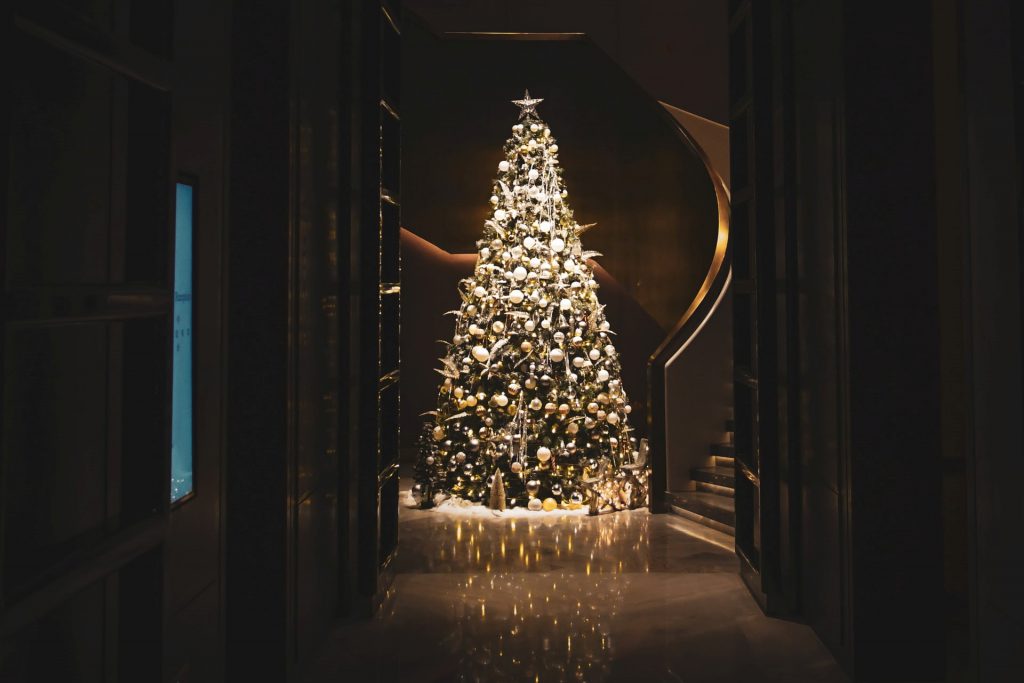
Christmas Tree – Origins in Pre-Christianity
Pre-Christianity, many civilizations used evergreen decorations. The Egyptians used green date palm leaves during the winter solstice. The Romans during Saturnalia decorated their homes with greenery. They are also believed to have attached candles to trees for the sun god, Sol and in addition they placed replicas of Bacchus, the fertility god on the trees. The Druids of Britain used mistletoe and holly in addition to evergreen branches. In Scandinavia, the Norsemen used the evergreen branches to symbolise the revival of Balder, the sun god. The closest to the Christmas tree was the ancient Germanic tradition of attaching candles and fruit to evergreen tree branches. This was in the practice of worshipping the god, Woden.
Christmas Tree Origins in Christianity
So where does the tradition of the Christmas tree originate from. Many scholars believe it could date back to St Boniface who lived in the 7th and 8th Centuries, better known as the patron Saint of Germany. During his attempts to turn Germany into a Christian society, he came across a group of pagans who were worshipping an oak tree in Geismar. The oak tree was believed to be a symbol for the god, Thor. To stop this act, he is believed to have cut down the oak tree and in its place a fir tree sprung up. He took this to be a sign of the Christian faith. Although he took this to be an indication of Christianity, the tree was not carried into the home.
The First Christmas Tree
The first true Christmas tree can possibly be traced to 1441, to the Estonian city of Tallinn. A tree was placed in the Town Hall Square at Christmas by the Blackheads, a fraternity of the town’s unmarried merchants. They would party around the tree, drinking, dancing and singing with girls. At the end of the partying the tree would be burnt. Still the tree remained outside.
Many scholars though believe that it was Martin Luther who was the first person to introduce the Christmas tree. He used the tree as a symbol for the Protestant faith, in opposition to the Catholic Nativity scene. But the first Christmas tree was documented 60 years after his death. If it was Luther, legend describes how on one Christmas Eve around 1500, he was walking home and struck by the beauty of the small evergreens covered in snow, he cut one down and took it home. He set the tree up inside his home and decorated it with candles, to honour the birth of Christ. The candles symbolising the light on the first Christmas.
In the early 18th Century, it had become common practice for trees to be brought into the home of towns of the upper Rhine. Wax candles on the tree came a lot later than the Luther story, probably in the late 18th Century. As it was seen as a Protestant symbol, it was only when the Congress of Vienna in 1815, did the tree become more popular. It was spread there by the Prussian officials. The practice of bring in the Christmas Tree was popular amongst the nobility and Royal Courts of Europe. In Austria, popularity was generated by Princess Henrietta of Nassau-Weilburg. In France by the Duchesse d’Orléans.
In Britain, it was Queen Charlotte of Mecklenburg-Strelitz, wife to George III but the custom did not spread beyond the Royal Family. Queen Victoria would have been familiar with the custom. She even mentioned it in her personal diary, for Christmas Eve 1832. Although much of the credit to the introduction of the Christmas Tree into Britain is given to Prince Albert. It is in fact a print in the Illustrated London News of December 1848 that was the impetuous that popularised and made Christmas Trees fashionable.
The original variety of tree was the German Springelbaum, which was imported. But in the 1880’s the Norway Spruce became more popular as it was cheaper and home grown. Trees were initially displayed in pots and placed on tables and gifts left under the tree unwrapped. With the popularity of the Norway Spruce and as the trees became larger, the trees were placed on the floor.
Traditions have built up about the Christmas tree. In Germany and elsewhere in Europe it is common practice to put the tree up on Christmas Eve and take it down on Epiphany, 6th January, the Twelfth Night. This though is not the norm anymore. Christmas trees are brought into the home, days even weeks before Christmas Eve. In America the tradition is to wait until the second week in December and in Australia, it is the 1st of December. Due to the commercialisation of Christmas, large department stores will have artificial trees on display as early as September.
Artificial Christmas Tree
History of the artificial Christmas tree can be dated back to 1747 in the United States. A German immigrant in Pennsylvania, built wooden tree shaped pyramids and decorated them with candles. But the first artificial Christmas trees were developed in Germany in the 1880s. The original artificial trees were made of goose feathers that had been dyed. By the 1920’s, department stores were selling the trees in various heights from just 5cm to 2.5 metres.
The artificial trees started to evolve in the 1930’s in America. The trees were made from brush bristles. In 1958 the aluminium tree was introduced in Chicago. But today the trees are now made of polyvinyl chloride more commonly known as PVC and other plastics. In more recent years the fibre optic Christmas trees have become popular.